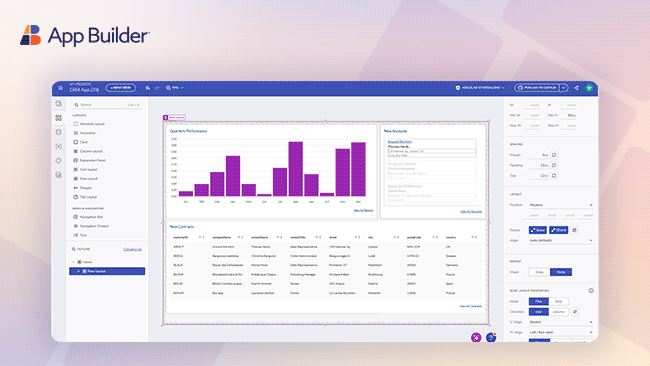

What’s The Low-Code Future for CTOs & Development?
Low code has become a catalyst for rapid digital transformation in companies of different sizes and industries. These tools see steady growth in their impact on business—from remodeling the entire corporate culture that implements rigid structures focused on traditional workflows to establishing innovative hubs that are more agile and prepared for any market change.
But what’s the low-code future for development, CTOs, and executives? What should they know?
Usually, it’s all about business agility, growth, ROI, faster time to market, and impact on development jobs. While these drive interest in low-code adoption, there are also less discussed vital factors that C-level executives must consider to understand better how the low-code development future will unfold.
So, let’s explore them.
Low-code development now introduces various opportunities and challenges for businesses. However, before benefiting from the positives, companies need to establish a strategic vision and see low code as more than an instrument that simplifies app development. This is, at the core, true. All the advantages that low-code tools bring to the table can become useless unless they are supported by the following:
- Clear guidelines and governance.
- An adaptable organizational mindset.
- A long-term vision for digital transformation.
Any shift in app development paradigms can pose implications, and CTOs must be ready to navigate them. Here is everything they need to do to fully capitalize on the low-code development future and low-code tools.
From Technology Acquisition to People Development
One of the most significant shifts that the low-code future asserts is rethinking the role of development teams and the app-building cycles. The global reach of tools like App Builder is increasing, and the adaptability to various industries positions them at the forefront when driving large-scale digital transformation, giving it significant long-term growth potential.

For enterprises, the advantages of low code are clear. The ability to reduce strain on IT resources, increase time to market, and involve the business in digital asset development makes App Builder a strategic solution for companies looking to accelerate innovation without overburdening their development teams.
Leveraging low code alters the skills developers prioritize. It encourages them to focus on problem-solving, understand business needs, become adept at pre-built solutions and functionalities, and be capable of providing precise instructions for low-code-driven systems.
What CTOs need to know:
- As manual coding becomes less central, skills related to integration, customization, and low-code platform management gain importance.
- The change fosters a better understanding of development, making skills like system design and optimization crucial alongside technical coding knowledge.
- There will be a mix of technical and non-technical skills—developers learn to bridge gaps between stakeholders, translate requirements into modular components, and identify where and how automation can be applied effectively.
Acceleration of Product Development From Design to Code
Platforms like App Builder empower developers with an intuitive drag-and-drop interface for rapid iteration, testing, and deployment of updates that take less time and resources. The low-code future is one where every process is streamlined and automated.
According to 451 Research, “the overall benefit of a DAP (digital automation platform) is speed. They can potentially shave 50-90% off development time vs. a coding language. We believe low-code DAPs will craft nearly half of all applications developed in the coming years because they take less time to prototype, test, and deploy to production.”
This way, teams can eliminate time-consuming tasks like designer-developer handoffs while prototyping and building MVPs happen 10x faster than traditional app development methodologies.
What CTOs need to know:
- Many manual aspects are automated, including image and data source generation, code generation for frameworks like Angular, Blazor, Web Components, React, code preview, etc.
- This translates to reduced development costs, better time efficiency, and the mentioned advantages – faster time to market, business agility and growth, and competitive edge to outpace other companies.
- While low-code platforms automate repetitive coding tasks, developers are still essential for complex system design, customizations, and high-level integrations that low-code solutions can’t handle independently.
Valuable resources for CTOs on the topic:
Maximizing Business Agility with Low-Code Development
How Can CTOs Achieve Faster Time to Market with Low Code?
Developers Will Still Be Essential, Even With Low Code
Low-code development is here to transform developers’ workflow, revamp how businesses deliver business agility and innovation and augment technical capabilities. Many companies initially feared introducing low-code platforms + AI might entirely replace traditional programmers. But this is different from what the low-code future holds.
What CTOs need to know:
- Developers who understand how to optimize and extend these platforms will remain vital.
- C-level executives and stakeholders learn how to use low-code tools as instruments that bring together fusion teams and boost developers’ productivity.
- Programming will evolve into roles where software-experienced developers manage complex apps and guide low-code-driven workflows while citizen developers handle repetitive and basic apps.
Valuable resources for CTOs on the topic:
The Truth About The Impact of AI on Software Development
A CTO’s Guide To Leveraging Non-Technical Talent
Low-Code Future, Suitability, & Specific Business Needs
The market will surely see the rise of many platforms—some will fit certain businesses, others won’t. What are the functional capabilities of low-code tools that CTOs and their teams need? When they have selected a platform, they must consider how it aligns with the company’s business needs. Understanding this is crucial.
Generally, these platforms excel at prototyping, building MVPs and scalable POCs, and developing lightweight apps. More comprehensive tools like App Builder automate everything from design to code, allowing teams to build feature-rich, enterprise-grade apps. Nevertheless, CTOs must ensure the chosen tool corresponds to the organization’s long-term performance expectations and scalability requirements.
What CTOs need to know:
- Carry out thorough testing for scalability and performance in advance. The reason is that most organizations struggle with low-code apps under high transaction demands because they still need to evaluate the platform.
- Be prepared to transition some prototypes to traditional development in case of scalability limits within the low-code tool.
- Some low-code tools lack deep customization options. That’s why CTOs should always consider the flexibility, toolset, and platform’s functionalities before implementation. If the platform allows for extensibility through APIs, integrations, or custom code, that’s great!
Valuable resources for CTOs on the topic:
6 Steps For Building an MVP Fast With Low-Code Platforms
New Financial Viabilities & Operational Impacts
Low-code tools are a sound investment for businesses that optimize their operations, ROI, development productivity, and costs. Even though these platforms come at a price, there are flexible plans, and the investment pays off in the long run. There is financial viability and operational scalability. However, there are certain aspects that C-level executives must consider for the future of low code.
What CTOs need to know:
- Managing the operational impact includes planning for system downtimes during integration phases.
- It’s important to have contingency plans in case of failures or performance issues during the initial rollout.
- To ensure that the investment delivers continuous value over time, regularly evaluate the ROI. Measure KPIs such as development speed, cost savings, user adoption rates, etc.
Valuable resources for CTOs on the topic:
Low-Code vs Traditional Development: Cost-Benefit Analysis for CIOs
*embed this link* https://www.youtube.com/watch?v=AfbJK05NSj0
A Low-Code Future of Seamless Integration… But How?
Low-code platforms usually come with pre-built connectors that allow the integration of their applications with common, widely used services like CRM platforms and cloud storage systems. As technology evolves, the low-code future promises to enable businesses to connect to traditional systems, emerging technologies, and niche tools.
However, these solutions may not integrate easily with legacy systems or more complex environments.
What CTOs must know:
- Having robust integration capabilities is a must. This will ensure the low-code platform works with existing systems without causing inefficiencies or disruptions.
- Prioritize robust support, continuous updates handled internally, and a strong, active community.
- Only properly integrated platforms will eliminate the risk of data silos and system operations.
Valuable resources for CTOs on the topic:
Guide: Eliminating Low-Code Challenges and Mitigating Risks
Wrap Up
The global reach of tools like App Builder is increasing, and its adaptability to various industries positions it as a critical player in driving digital transformation at scale. The ability to reduce strain on IT resources, increase time to market, adapt to specific business needs, and involve the business in digital asset development makes low-code tools like App Builder a strategic solution for companies looking to accelerate innovation without overburdening their development teams.
For CTOs, the low-code future poses various opportunities for fostering innovation and introducing new technological approaches. By strategically evaluating and adopting low-code tools, C-level executives are empowered to future-proof their organization and create a more collaborative culture where experienced programmers and citizen developers build modern-day apps in a cost- and time-efficient way.
So, at the core of the low-code future lies the idea of shaping a more agile and flexible organization with a competitive edge. It’s no longer just about simplifying app development.



